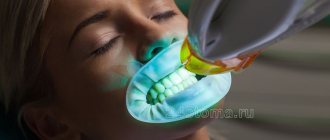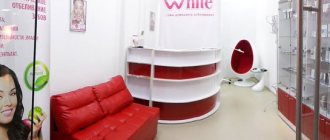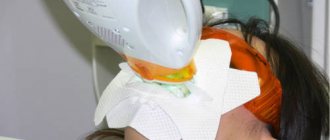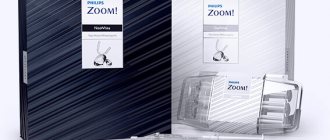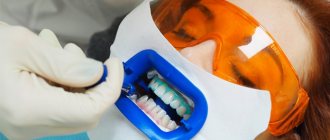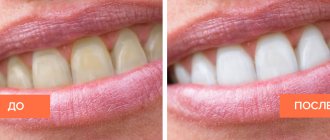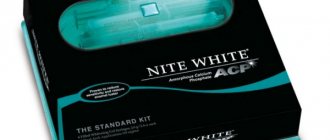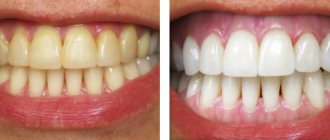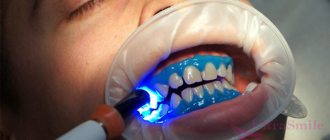Author of the article:
Soldatova Lyudmila Nikolaevna
Candidate of Medical Sciences, Professor of the Department of Clinical Dentistry of the St. Petersburg Medical and Social Institute, Chief Physician of the Alfa-Dent Dental Clinic, St. Petersburg
Cold lamp teeth whitening is one of the most modern ways to lighten enamel. The procedure is carried out using a special LED lamp with cold light.
This method is often confused with whitening with a conventional incandescent lamp, which heats the enamel, which is unsafe for the teeth, as it leads to their cracking, and also causes a lot of unpleasant sensations during the process itself. It is no wonder that patients are often distrustful of lamp bleaching.
The impact of an LED lamp is very different from a standard one; Let's figure out how effective and safe it is, and whether we should be guided by old stereotypes.
The essence of lamp whitening
It cannot be said that in this procedure, whitening occurs thanks to the light produced by the LED lamp. The bottom line is that light is only a catalyst for a chemical reaction between the reagent and the pigments that are inside the enamel and are responsible for its color.
In order to neutralize the yellow tint, a special gel based on hydrogen peroxide is applied to the teeth. Light exposure to this substance activates oxygen, which penetrates the tooth tissue and oxidizes pigments. Thus, light rays stimulate the chemical process, making the procedure safer and faster.
The main advantage of this method is that the light from the LED lamp practically does not heat the enamel, and therefore does not harm it.
Sequence of the procedure
Before performing the procedure, the patient wears protective equipment: glasses, an insert for the mouth and face. The procedure consists of several stages:
- professional cleaning;
- determination of the initial color of teeth;
- protection of soft tissues using insulating material;
- covering the gingival margin with a protective gel;
- distribution of whitening gel over the upper and lower teeth in the smile line;
- activation of the gel using equipment (from 3 to 4 cycles, each cycle takes up to 10-15 minutes depending on the characteristics of the whitening lamp);
- each cycle is carried out using a new portion of whitening gel;
- rinsing off the gel;
- remineralization of teeth.
When whitening using Philips Zoom technology! WhiteSpeed (Zoom 4) exposure occurs using ultraviolet radiation. Warm and cold light lamps are used. The procedure is repeated several times until maximum results are achieved.
Philips Zoom lamp! WhiteSpeed (Zoom 4) is positioned so that the light falls simultaneously on the upper and lower teeth in the smile line. Under its influence, active oxygen is released from the components of the whitening gel. Its molecules eliminate the most persistent stains from the tooth surface. Upon completion of whitening, a drug is applied to further strengthen the tooth enamel.
The gel itself also contains special components that protect the surface of the teeth and reduce the sensitivity of the enamel to external factors. This happens not only during the procedure, but also in the future: the enamel becomes stronger and less sensitive.
Cold teeth whitening: stages
Enamel lightening with gel and a lamp is exclusively an in-office procedure that should be performed by a trusted specialist. Otherwise, you risk damage to the enamel, irritation of the oral mucosa and other problems.
The whitening itself lasts about an hour and is carried out in several stages.
Preparation
Before any whitening, no matter which method you choose, you should prepare your teeth very carefully:
- Firstly, this concerns the elimination of various scratches and chips on the enamel, as well as the treatment of caries. If you don't do this, the active gel may get into the cracks and act too deeply on the tissue, which will cause you a lot of discomfort both during and after the procedure.
- Secondly, pay special attention to fillings and implants; their color will not change due to bleaching, so it is better to choose temporary options and install permanent ones after the procedure. Otherwise, the color of your smile will not be uniformly white.
- Thirdly, mechanical or ultrasonic cleaning is always necessary before whitening; it will remove soft and hard plaque from the teeth, which will help determine the natural color of your enamel as accurately as possible. Cleaning itself will make your smile one or two shades brighter. Next, you can choose the color of the enamel using a special VITA scale. Next, the bleaching itself begins.
Stages
- The first stage begins with preparing the oral cavity for the procedure; this is necessary to protect the soft tissues. The cheeks and lips are isolated using various napkins and films so that the gel does not accidentally come into contact with them when treating teeth. A protective composition is also applied to the gums so that the aggressive effects of the gel do not cause irritation and other problems. The most popular option is liquid rubber dam; the advantage of this composition is that it quickly hardens, forming a dense protective film.
- The second stage is the whitening procedure itself, the surface of the teeth is thoroughly dried and then evenly coated with the active composition. Next, the teeth are irradiated with an LED lamp for about 10 minutes and the gel is removed. If the color is not white enough, the procedure is carried out again. During one visit to the dentist, it is possible to make no more than three approaches.
- Special restorative compounds are applied to the teeth.
The whole procedure takes about an hour. The result is individual for everyone, so do not despair if you did not get the desired color on your first visit; most likely, with repeated procedures you will achieve the desired shade.
Principle of procedure
A special preparation with an optimal percentage of hydrogen peroxide and calcium phosphate (it neutralizes the effect of oxygen on the enamel) is applied to the crown of the dentition. The whitening process is activated by a cold UV lamp. This method lightens the enamel up to 10 tones. The color of teeth remains for a year or more, subject to the doctor’s recommendations.
In addition to cosmetic teeth whitening, the white system has a healing effect on the enamel: the drug fills microcracks and chips, thereby strengthening the enamel, and ultraviolet rays disinfect the oral cavity.
The procedure takes no more than 1 hour, the patient does not experience any discomfort during this time. After photowhitening with the zoom device is completed, the patient may experience increased tooth sensitivity, which goes away on its own after a few hours.
Any dental procedure has indications and limitations for its implementation. Teeth whitening using ZOOM technology is no exception.
Clinical teeth whitening zoom is recommended for:
- significant darkening/yellowing of the enamel as a result of constant consumption of drinks containing dyes and smoking;
- age-related changes in the shade of teeth;
- the presence of a disease that causes enamel pigmentation, the formation of stripes, spots - fluorosis;
- changes in the shade of enamel due to long-term treatment of certain diseases with drugs of the tetracycline group;
- the patient’s desire to improve the aesthetics of their teeth.
How effective is teeth whitening with LED light?
Modern cold bleaching is a very effective method. Depending on your individual characteristics, in one visit to the dentist you can lighten your tooth enamel by about 6-10 shades. Provided that your teeth have acquired a yellow tint due to food or smoking. If your enamel has acquired a gray tint, lightening with an LED lamp will not give significant results, that is, the shade will change by 2-3 tones. In addition, the procedure will not work if a change in the healthy color of the enamel is caused by taking tetracycline antibiotics or an excess of fluoride in the body.
The results of whitening with an LED lamp can last for several years, depending on the natural shade of the enamel and how carefully you follow your dentist's recommendations.
Recommendations after teeth whitening zoom 4
To avoid pain after zoom teeth whitening, be sure not to neglect the doctor’s recommendations. If you require a course of remineralization therapy before you even think about aesthetics, this is the surest way to prevent tooth sensitivity after the procedure.
But it often happens that teeth hurt after zoom whitening, even if the strength and mineralization of the enamel was not in doubt. This can be explained by the fact that the tubules passing through the thickness of the enamel and dentin became free again, and therefore began to actively conduct irritants to the pulp - the “brain” of the tooth.
From the outside it seems that the enamel is hard and impregnable, but in fact it is all dotted with tubules that come to the surface as pores. When we eat food (sweet, salty, sour, etc.), the fluid inside the tubules begins to move osmotically. This causes a reaction - pain.
What to do? How to relieve pain after zoom teeth whitening?
Try to avoid provocations - do not eat sour, salty, sweet, hot, cold foods. Over time, the pores on the surface of the enamel will close somewhat. And after each teeth whitening session, the dentist will apply a remineralizing agent, which will make the dental tissues stronger and more resistant to various irritants.
White diet after teeth whitening zoom
To prevent the pores in the enamel opened with the help of a chemical agent and laser from absorbing new pigments from food, it is recommended not to eat colored foods for the first time after a teeth whitening session.
Food pigments are found in all vegetables, fruits, and drinks that have a color other than white. That’s why this diet was called “white”.
The diet after teeth whitening zoom 4 may consist of dairy products, mushrooms, bananas, peeled apples and pears, cauliflower, potatoes, white cabbage, pasta and other dishes made from white flour, white fish, poultry, rice, pearl barley, oatmeal, beans , eggs (without yolk).
As you can see, you can maintain a sufficient amount of proteins, carbohydrates and fats in your diet to obtain energy and maintain processes necessary for beauty and health.
Is there any harm in zoom teeth whitening?
Could such gentle and non-aggressive zoom teeth whitening have disadvantages?
Of course, if the tooth tissue does not have a structure sufficiently saturated with minerals, each new enamel lightening session will cause irreparable damage. Teeth can become not only too fragile, but also hypersensitive.
Also, teeth whitening zoom 4 is harmful for those who do not have sufficient willpower. In order to adhere to the correct diet, strict self-control is needed. If you do not adhere to the recommendation regarding choosing products without pigments, your teeth can become even more stained.
Despite its high safety, zoom 4 teeth whitening also has contraindications. The procedure should not be performed if:
- pregnancy, breastfeeding;
- oncological diseases;
- increased sensitivity of enamel;
- caries and gingivitis;
- the presence of large fillings and prostheses of the front teeth.
All contraindications for zoom teeth whitening can be reviewed separately, because each clinical situation is individual.
Teeth whitening price zoom 4
The cost of zoom 4 teeth whitening depends on the system used during the session. The price is also influenced by the reputation of the clinic and the doctor, as well as the professionalism and experience of the dental staff. Prices in clinics that are located closer to the city center or busy, popular places are also higher.
If you would like to get a good discount, you can use coupon sites. Thus, clinics and beauty salons often try to attract more people. Look for coupons or certificates that say “Teeth whitening zoom 4: promotion!”
But how much does zoom teeth whitening cost approximately? The price of the course is between 10-25 thousand rubles. Home systems for self-use are cheaper, but they contain a gel with a lower concentration of the active substance, so they whiten teeth much more slowly.
In addition, even if the cost of zoom teeth whitening seems significantly higher than using a home system, it is worth remembering that in addition to the set of gel and lamp, it is recommended to make an individual mouth guard. This will allow you to use the gel sparingly, as well as surround the teeth more tightly with the drug.
Why does tooth enamel darken?
To get the most out of lamp whitening, you need to understand the causes of darkening of tooth enamel. In most cases, it is enough to eliminate the negative impact and clean the teeth so that the color of the teeth becomes natural again.
Dentin has a dark shade, which shines through a thin layer of enamel. A fair question arises: how does it happen that dentin darkens if the enamel is strong and can protect the tooth from many negative factors?
The reason is quite simple. It lies in the universal love for solid foods and sour drinks. Seeds, nuts, lemonades and other similar products contribute to the deformation of the upper layer of teeth. Through scratches and chips, pigments easily penetrate into the tooth tissue, staining the dentin.
The main factors influencing the color of teeth:
- The most popular reason is the consumption of foods that contain large amounts of coloring substances. These can be the following things: cranberries, blueberries, beets, strawberries, various candies and sodas, coffee, strong tea and much more. If this is the reason for the darkening of your teeth, then careful hygiene and periodic professional cleaning (once or twice a year) will help.
- Change • Change in enamel color is common in smokers. The main problem here is the tar that is in the cigarette. Together with smoke, they fall on the surface of the teeth and settle in the form of a dark plaque. Gradually, this sediment destroys tooth enamel, which can lead to caries and more serious diseases. In addition, smoking also has a negative impact on your gums. The best option in this case would be to quit smoking completely. If this is not possible for you, try to reduce your cigarette consumption to a minimum and pay more attention to oral hygiene.
- The tooth may darken due to injury, which led to damage to the neurovascular bundle. In this case, consultation with a specialist is necessary. Until the cause is eliminated, whitening will not help lighten the tooth.
- The shade may change due to the removal of the nerve; the darkening may not appear immediately, but also requires the intervention of a specialist.
- Filling a canal can lead to staining of the enamel; it all depends on the material used to fill the hole.
- Progressive caries is an advanced case of ordinary caries. The fact is that if such damage is not eliminated, small black spots will increase, destroying the enamel and then the dentin.
- Teeth may have congenital characteristics that are in no way related to caries or other damage. They can differ in structure, tone, shape, and so on. In some cases, it is possible to change their color only with the help of special overlays - veneers.
- Excess fluoride in the water you drink can lead to fluorosis. At the beginning of the disease, dark spots or chalky streaks appear on the teeth. The progression of the disease leads to the destruction of enamel and then dentin. Whitening such teeth is not possible until you get rid of fluorosis.
- Taking tetracycline antibiotics during pregnancy can negatively affect the condition of the baby's teeth.
Teeth whitening and lightening should not be confused. Lightening will not give you a shade brighter than your natural tooth color.
When teeth are lightened, pigmented plaque is removed, nothing more. This plaque forms if you eat a large amount of coloring foods. Especially coffee, tea, various sauces (for example, soy), etc. Smoking, of course, also negatively affects the color of teeth. So teeth whitening is nothing more than professional oral hygiene, cleaning, and removal of dental plaque. You can lighten your teeth a little at home using abrasive toothpastes and powders. But all this is not bleaching! All these manipulations have no effect on the pigment inside the tooth.
Any whitening can be carried out only after consulting a specialist.
Let's figure out what types of whitening exist.
Absolutely all teeth whitening always occurs due to a chemical reaction, with or without activation of the whitening gel.
- Whitening without activation occurs by applying a gel to the surface of the teeth.
- Heat-activated whitening using ultraviolet lamps and diode lasers.
- Whitening with activation without generating heat using cold light lamps.
Types of whitening
All types of whitening can be divided into two groups:
- Clinical whitening
- Home whitening
The whitening process occurs due to the action of hydrogen peroxide/urea on the pigment. Hydrogen peroxide begins to work actively after 30-60 minutes, while carbamide peroxide after 2-6 hours.
The color of teeth is given by pigment found in dentin, the tissue located under the enamel. The pigment can have either a yellow or gray tint.
It is by acting on this very pigment that atomic oxygen released by carbamide peroxide or hydrogen peroxide makes teeth whiter.
So, clinical whitening is carried out in the clinic, under the supervision of a dentist. The doctor must be trained and have a certificate giving him the right to perform this procedure efficiently and correctly.
Lampless whitening
One of the lampless systems is the Philips Zoom! QuickPro. This procedure takes a little time. In the clinic, the dentist applies varnish with 20% hydrogen peroxide to the teeth. And then covers them with a special sealing layer. After 30 minutes, the patient removes the varnish with a toothbrush and enjoys white teeth.
Lamp whitening
Lamp whitening speaks for itself. The whitening gel is additionally activated to penetrate deeper into the tooth tissue, which makes the procedure more effective compared to lamp-free whitening.
Home whitening.
It is carried out independently, at home. For this, whitening strips, standard trays with gel, or individual trays can be used. Of course, it is better to give preference to individual trays - this reduces the risk of the whitening gel getting on the gums, which can cause a burn, and whitening occurs evenly. Depending on the patient's preferences, you can choose a day or night home whitening system.
A home whitening system should be selected for you by a dentist.
The advantage of home whitening systems is their lower cost, there is no need to visit a doctor, the procedure is carried out independently, at a time convenient for you, but the whitening time may take several weeks, and the effect may not be as bright.
Home whitening systems. Philips Zoom! DayWhite system for daytime home whitening, contains 9.5% hydrogen peroxide. Takes approximately 30 minutes twice a day, morning and evening Philips Zoom! NiteWhite overnight home whitening system contains 16% or 22% carbamide peroxide and is used overnight (5-7 hours). Opalescence PF is available in syringes with gels containing 10, 15 or 20% carbamide peroxide. This gel is added to the trays. Thanks to its density, the mouth guards are securely fixed. Opalescence tres white are ready-made standard trays with 10% hydrogen peroxide gel. There are 10 of them in the set. Basically, these trays are used to lightly refresh the color of teeth, as well as to consolidate the result after clinical whitening. Their advantage is that they do not require the cost of making individual mouth guards, and they are convenient to use while traveling. There are also various markers and felt-tip pens for teeth whitening, but you need to understand that it is impossible to achieve a clear result with them. When choosing a whitening system, it is important to find a certified product. And before teeth whitening, be sure to consult with a specialist to find out if there are any contraindications.
During chemical whitening, highly concentrated whitening gels are used.
Clinical whitening gives immediate results. If you are preparing for any event, then clinical whitening is right for you.
Laser whitening SmartBleach 3LT emits green light and gives good results with any discoloration, even with tetracycline staining of teeth. The result lasts from 2 to 5 years. The procedure takes on average about 30 minutes.
Philips ZOOM WhiteSpeed is a modern, safe whitening system. For whitening, a 4th generation LED lamp is used, with three intensity modes. Thanks to this, you can carry out the whitening procedure comfortably and achieve the desired result. The effect lasts up to 5 years. If you carry out maintenance home whitening procedures, the tooth color acquired after the clinical stage can remain for many years.
Express whitening in hairdressing salons
Powerful advertisements for teeth whitening in beauty salons and studios of any format introduced a large number of people dreaming of a Hollywood smile to express whitening - a technique that allows you to get in 30 minutes, although not ideal, not long-term, but still, the result of a color change teeth towards improvement. This service has nothing to do with medical whitening. Before performing clinical whitening, you must consult a doctor, as there are contraindications to this procedure. You can entrust your teeth only to a competent, certified specialist who has completed more than one training course with doctors who deal with professional discoloration. How can you entrust your health to a person who has not studied medicine and has never improved his qualifications? Manipulations performed in the egg chair (the place where these dubious procedures are performed) can lead to serious complications: the appearance of hypersensitivity, burns and gum recession. Who will help you solve these problems? It is unlikely that a girl working in a hair salon will cope with such situations. Medical interventions have a preventive, therapeutic, rehabilitation focus. A medical license is required to provide clinical whitening services. Can an office be licensed in a shopping center where there are no doctors on staff?
We encourage everyone to take any procedures performed in the oral cavity more seriously and trust their health to professionals. We have been providing clinical whitening with the Philips ZOOM WhiteSpeed system for many years. We are confident in the results of this type of whitening and in the safety of this system.
Benefits of lamp teeth whitening
The main advantage of the LED lamp, which is used for teeth whitening, is the almost complete absence of harm to the patient. This method has passed all clinical trials and is considered one of the safest. Radiation from the source passes through a special filter that neutralizes the negative effects of ultraviolet and infrared radiation. The temperature of the enamel surface during the procedure does not exceed 37.6ºC.
You can also note other advantages of cold whitening:
- Short procedure time;
- The ability to get the desired result in one go;
- The active gel applied to the teeth has a special composition that helps reduce sensitivity to the procedure.
- The system allows you to whiten teeth that have darkened with age or their color is a consequence of fluorosis.
The disadvantage of the procedure is its high cost and a long list of contraindications.
Instructions for use White Light
The rules for using the White Light teeth whitening system are quite simple, however, you should read them carefully to achieve maximum results.
Stages of the procedure:
1. Perform thorough oral hygiene using a brush and floss.
2. Prepare the White Light kit for use.
3. Apply two types of gel alternately to the surface of the tray with a thin strip (5 millimeters wide): first whitening, then with the active component.
4. Insert the mouthguard into your mouth and clamp it with your teeth.
5. Place the light device in your mouth, fix it with your lips and turn it on.
6. After 10 minutes, the device will turn off automatically. Then during the day you can repeat the procedure several times, but the total procedure time should not exceed 30 minutes daily. The course can last up to two weeks.
7. Upon completion of the procedure, rinse the whitening device and tray under the tap.
During whitening, you should take precautions: do not allow the gel to get into your eyes, rinse them immediately if this happens, and also make sure that the product does not come into contact with the skin (this can cause irritation).
How long will the whitening gel last?
The gel included in the White Light whitening system is enough for about a week of daily use. If you want to extend the procedure for another week, you can purchase an additional set of gels.
Contraindications
You should not resort to whitening with an LED lamp in the following cases:
- high sensitivity of teeth;
- defects on enamel;
- pregnancy or lactation (there are other methods);
- intolerance to the active components that make up the gel;
- fixed dentures, crowns or a large number of fillings;
- The procedure is also not recommended for children under 16 years of age;
- caries, periodontitis and other diseases.
In the latter case, the ban is temporary, since the procedure can be carried out after you have treated your teeth.
Contraindications to Zoom
It is not recommended to use the device for enamel whitening in the following cases:
- Presence of cancer.
- Age restrictions – up to 18 years.
- Pregnancy and breastfeeding.
- During the period of correcting the bite with braces and for six months after their removal.
- The presence of dentures and fillings makes it impossible to increase the whiteness of an artificial tooth. Therefore, before performing the whitening procedure, you need to install a prosthesis of a specific shade. Then the whitening of living teeth is carried out in accordance with the color of the prosthesis.
How to save the result
Once you've gotten the whiteness you wanted, don't forget that your teeth now need more careful care. For a week, it is best to follow a clear (white) diet, the essence of which is to exclude coloring or very hot foods. It is also better to reduce your cigarette consumption.
In addition, professional products from the ASEPTA series for oral care will help you. They will prevent the appearance of yellow plaque, caries and other troubles, for example, ASEPTA Sensitive toothpaste will help reduce tooth sensitivity after the procedure. In the future, you can use ASEPTA PLUS Remineralization or Gentle Whitening toothpaste to maintain a snow-white and healthy smile.
Sources:
- Report on determining/confirming the preventive properties of toothpaste “ASEPTA PLUS” GENTLE WHITENING” Author: doctor-researcher A.A. Leontyev, head Department of Preventive Dentistry, Doctor of Medical Sciences, Professor S.B. Ulitovsky First St. Petersburg State Medical University named after. acad. I.P. Pavlova, Department of Preventive Dentistry
- Report on the determination/confirmation of the preventive properties of personal oral hygiene products “ASEPTA PLUS” Remineralization doctor-researcher A.A. Leontyev, head Department of Preventive Dentistry, Doctor of Medical Sciences, Professor S.B. Ulitovsky First St. Petersburg State Medical University named after. acad. I.P. Pavlova, Department of Preventive Dentistry
- Clinical studies of antisensitive toothpaste “Asepta Sensitive” (A.A. Leontyev, O.V. Kalinina, S.B. Ulitovsky) A.A. LEONTIEV, dentist O.V. KALININA, dentist S.B. ULITOVSKY, Doctor of Medical Sciences, Prof. Department of Therapeutic Dentistry, St. Petersburg State Medical University named after. acad. I.P. Pavlova
- Report on determining/confirming the preventive properties of toothpaste “ASEPTA PLUS” COFFEE and TOBACCO Author: doctor-researcher A.A. Leontyev, head Department of Preventive Dentistry, Doctor of Medical Sciences, Professor S.B. Ulitovsky. First St. Petersburg State Medical University named after. acad. I.P. Pavlova, Department of Preventive Dentistry
How to maintain the effect of the procedure?
How long the result lasts depends on the patient himself, or more precisely on his lifestyle. If he is a heavy smoker, a coffee drinker, and often consumes foods with a high content of dyes (blueberries, oranges, sweets, etc.), he risks soon saying goodbye to the whiteness of his smile.
It is known that the effect of whitening devices stabilizes only after 10-14 days. During this time, dentists recommend following a “white” diet, since the enamel has not had time to recover and the constant influence of harmful factors can spoil the effect of the procedure.
You can maintain and improve results at home. There are different systems to choose from that contain plates or trays. They are applied in a course of 7-10 days.
